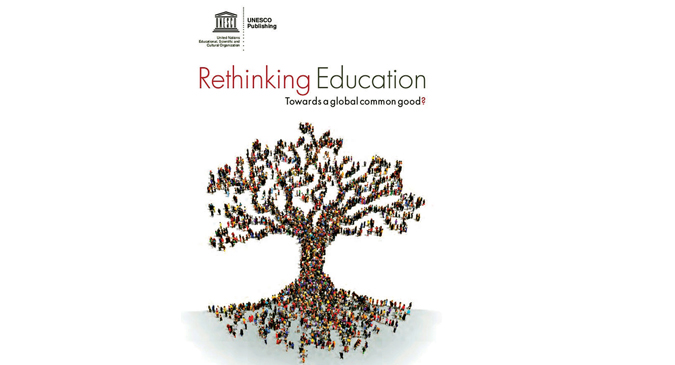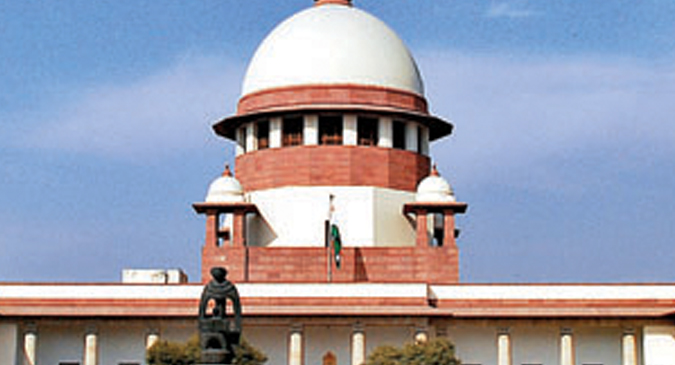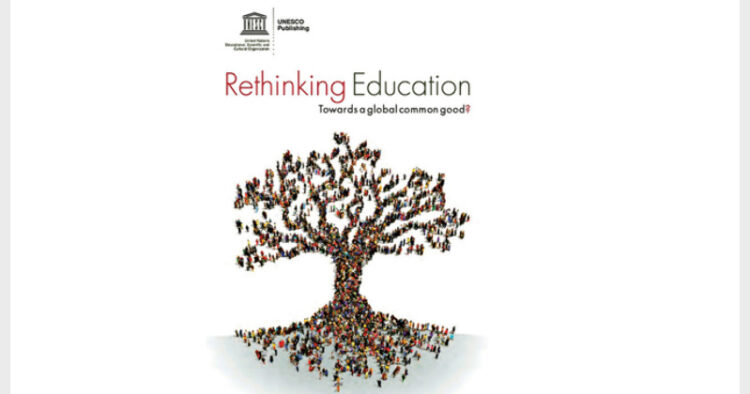The basic purpose of the Sanskrit prayer recited in Kendriya Vidyalaya is to Re-affirm Humanistic Approach in Education with the idea of ‘Be Humane’ to teach TO LIVE TOGETHER
Prof Chand Kiran Saluja
Addressing the basic, as well as larger issues of education with special reference to the aims and purposes of education in the present larger technocrat era it becomes necessary to look into the type of society in which we are and also to which we aspire to live in. Though the economic functions of education have been considered in the present era, important and thus cannot be ignored, but it cannot be strictly delimited to these only. One has to go beyond the utilitarian vision or the human capital approach to education, which signifies much of international development discourses at present. The present era is considered to be the era of Humanistic Approach to education, which reflects Universal Ethical Principle of integrated approach to life:

“A humanistic vision reaffirms a set of universal ethical principles that should be the foundation for an integrated approach to the purpose and organization of education for all. Such an approach has implications for the design of learning processes that promote the acquisition of relevant knowledge and the development of competencies in the service of our common humanity. A humanistic approach takes the debate on education beyond its utilitarian role in economic development. It has a central concern for inclusiveness and for an education that does not exclude andmarginalize. It serves as a guide to dealing with the transformation of the global learning landscape, one in which the role of teachers and other educators continues as central to facilitating learning for the sustainable development of all.” (UNESCO Report, Rethinking Education: Towards a global common good?)

It was well addressed in 1990 as a title of the report of the committee on review of educational policy 1986, under the chairmanship of Acharya Ramamurthi as `Towards Humane and Enlightened Society’. It is to be remembered that in our country Education is given a status of Fundamental Right under Article 21(A). Article 21 of the Constitution is related to ‘Right to Life’. It clearly implies that education has been seen as a means to life. It also has to be seen in the light of the four Basic Values of Preamble of our Constitution. It is also to be remembered that Right to Life includes ‘finer graces of human civilization’. Various other Human Rights are included in this right, such as:
- Right to live with human dignity.
- Right to Health (including mental health)
- Right to healthy environment.
- Right to education
- Right to livelihood
- Right to live peacefully etc.
Human Rights are considered as bench mark for these rights. These have to be looked into the Cultural, Social, Ethical, Civic and as well as Economic Dimensions of the society concerned in larger global context. It is well maintained in UNESCO reports again and again that Education is not only about the acquisition of skills, it is also about values of respect for life and human dignity required for social harmony in a diverse world as a whole and not limited to some communities. It is to be understood that ethical issues are fundamental to the development process of human beings. Such an understanding enhances the role of education in developing the capabilities required for people to lead meaningful and dignified lives. The purpose of education must therefore be revisited in light of a renewed vision of sustainable human and social development that is both equitable and viable. This vision of sustainability must take into consideration the social, environmental and economic dimensions of human development and the various ways in which these relate to education: ‘An empowering education is one that builds the human resources’. (Rethinking Education: Towards a Global Common Good)
- With reference to the PIL filed in the Supreme Court on recitation of prayers in Sanskrit at KVs, the question whether ‘Sanskrit is against secularism?’ has been clarified by the SC in the Past
- UNESCO reports again and again that Education is not only about the acquisition of skills, it is also about values of respect for life and human dignity required for social harmony in a diverse world as a whole and not limited to some communities
With reference to aims of education it is very clearly visualised that ‘one has to be productive, to continue to learn, to solve problems, to be creative, and to live together and with nature in peace and harmony. When nations ensure that such an education is accessible to all throughout their lives, a quiet revolution is set in motion: education becomes the engine of sustainable development and the key to a better world.’ (Unesco Report, Rethinking Education: Towards a Global Common Good?)
Education can, and must, contribute to a new vision of sustainable global development to live together a `dignified Human Life’. Discussing the question of education in the life of a human being it was recognised by Supreme court of India that education ‘lays the foundation for a full and intense life and so this education must carefully keep alive the spark of curiosity and fan it into a beautiful, bright flame whenever it comes. It has been stated that it is the education received in early stages, which widens the contacts of child or youth with the surroundings of the world; and with every new and fruitful contacts with the world of things, the world of men and the world of ideas, life of the young becomes richer and broader. It is early education which seeks to broaden the mind by exposing the learner to the world of thought and reflection, which can inspire him with lofty idealism by giving him the glimpses of a good life which a worthy education is capable of bringing.’ (SC, Shri Santosh Kumar and Others Vs GOI)
With reference to the PIL filed in the Supreme Court regarding recitation of morning prayers in Sanskrit by students of Kendriya Vidyalayas (KVs), the question whether ‘Sanskrit is against secularism?’ was clarified by the Supreme Court in the above case. Referring a nine-judge Bench of this Court in S.R. Bommai Vs. Union of India, 1994 (3) SCC 1, as a basic structure of our Constitution about secularism it was said that ‘it is apparent that we cannot give any direction about which it can be said that it is against the secularist requirement of our Constitution.’ It was added that ‘the basic requirements of secularism in as much as in Bommai’s case this exercise has been well done by the learned Judges. It would be enough for our purpose to note what some of the learned judges said in this regard. Sawant J., with whom one of us (Kuldip Singh, J.) agreed, quoted in para 147 of the report what Shri M.C. Setalvad had stated on secularism in his Patel Memorial Lectures, 1965. One of the observations made by Setalvad was that secular state is not hostile to religion but holds itself neutral in matters of religion. The further observation in para 148 is that the State’s tolerance of religion does not make it either a religious or a theocratic State. Ramaswami, J. stated in para 179 that secularism represents faiths born out of the exercise of rational faculties and it enables to see the imperative requirements for human progress in all aspects and cultural and social advancement and indeed for human survival itself.’
‘It would be profitable to note that according to Justice H.R. Khanna secularism is neither anti-God nor pro-God; it treats alike the devout, the agnostic and the atheist. According to him, secularism is not anti-thesis of religious devoutness. He would like to dispel the impression that if a person is devout Hindu or devout Muslim he ceases to be secular. This is illustrated by saying that Vivekananda and Gandhiji were the greatest Hindus yet their entire life and teachings embodied the essence of secularism (see his article “The Spirit of Secularism” as printed in “Secularism and India; Dilemmas and Challenges” edited by Shri M.M. Sankhdhar.) (para, 17)
`We also propose to refer to what was said by the Sanskrit Commission on the subject of “Sanskrit and National Solidarity” in Chapter IV of its report. The Commission has, in this context first stated that Sanskrit is the “embodiment of Indian culture and civilisation.” It then observes that the Indian people look upon Sanskrit as the binding force for the different people of this great country, which was described as the greatest discovery which the Commission made as it travelled from Kerala to Kashmir and from Kamarupa to Saurastra. The commission, while so travelling, found that though the people of this country differed in a number of ways, they all were proud to regard themselves as participants in common heritage and that heritage emphatically is the heritage of Sanskrit. According to the Commission one of the witnesses which appeared before it went to the length of suggesting that if the Sanskrit commission had come before the States Reorganisation Commission many of the recent bickering in our national life could have been avoided. (pages 80 and 81)’ (para, 18)
It was concluded that Sanskrit in no way be regarded as against secularism. Indeed, our constitution requires giving of fillip to Sanskrit because of what has been stated in Article 351. in which while dealing with the duty of the Union to promote the spread of Hindi, it has been provided that, it would draw, whenever necessary or desirable, for its vocabulary, primarily on Sanskrit. Encouragement to Sanskrit is also necessary because of it being one of the languages included in the Eighth Schedule.’ (para, 19)
We, therefore, conclude by saying that in view of importance of Sanskrit for nurturing our cultural heritage, because of which even the official education policy has highlighted the need of study of Sanskrit would not in any way militate against the basic tenet of secularism. (para, 20)
It is interesting to note that the four basic pillars of education for 21st century discussed in the UNESCO report titled as Learning: The Treasure within
- Learning to know
- Learning to do
- Learning to be
- Learning to live together
basically reflect the idea of Sanskrit literature as:
- ?????? ????????? ?????? ?????? (Learning to know)
- ??????????????????? (Learning to do)
- ??????? (Learning to be)
- ???????????? ????????? (Learning to live together)
It is well observed that these four pillars of learning are fundamentally under threat in the context of current societal challenges, and particularly the pillars of learning to be and to live together, which best reflect the socialisation function of education. The strengthening of ethical principles and values in the process of learning is essential to protecting these pillars of a humanistic vision of education.’
It is to be remembered that with the change of time language gives new shades to the words in different contexts. It is well explained in ‘Re-thinking Education’ on the context of Humanism. The Meaning of Religion today does not give the full shade of its etymological sense of its root, as commonly known from the root relegare (to connect)’ which implies the idea of to live together. In that way Education is a Religious Activity.
The basic purpose of the Sanskrit prayer recited in the Kendriya Vidyalaya (i.e. ?? ??????, ?? ?? ??????? etc. teaches the lesson to live together, to eat together) is to Reaffirm Humanistic Approach in Education with the idea of `be Humane’ to teach TO LIVE TOGETHER.
(The writer is a renowned Sanskrit scholar)














Comments